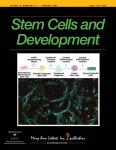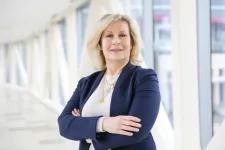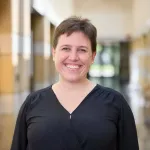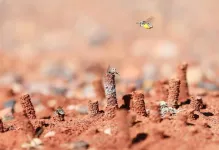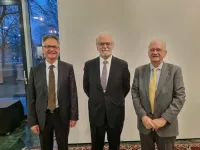(Press-News.org) Researchers from the University of Colorado Cancer Center have solved a cellular mystery that may lead to better therapies for colorectal and other types of cancer.
Peter Dempsey, PhD, professor of pediatrics–developmental biology in the CU School of Medicine, and Justin Brumbaugh, PhD, assistant professor of molecular, cellular, and developmental biology at CU Boulder, recently published a paper in the journal Nature Cell Biology showing the importance of the H3K36 methylation process in regulating plasticity and regeneration in intestinal cells.
“The intestine has an enormous ability to regenerate itself after injury, and it does this through a model of dedifferentiation,” Dempsey explains. “The cells dedifferentiate back into a type of regenerative stem cell after injury, and those stem cells eventually recover the intestine and turn back to normal cells.”
Finding the switch
Scientists have been looking for a long time for the “switch” that turns regular intestinal cells back into regenerative stem cells, Brumbaugh says. Using animal models, he, Dempsey, and the rest of their research team found that H3K36 methylation — a biochemical process that occurs within the H3 histone protein — is responsible for turning that plastic state on and off. Their research was funded by a grant from the CU Cancer Center.
“If you think about it, those cells that are normally in the intestine have to maintain their identity so they're functional,” Brumbaugh says. “You have to be sure that they don't flip when they're not supposed to, because you lose their specialized function — which is also a hallmark of cancer. There has been other research on histone modifications, because epigenetics makes sense to study in this context. It makes sense that you have this form of regulation that will prevent reversion and lock in cell fate.”
Next steps
With H3K36 methylation identified as the process responsible for the switch between normal cells and regenerative cells, the researchers say the next step is to look for ways to target the process to turn it off or on as needed to treat colorectal cancer and intestinal conditions that can lead to cancer.
“H3K36 methylation seems to be directly involved in differentiating the cells, but if you take it away, the cells revert to this regenerative stem cell state,” Dempsey says. “That regenerative state is important when you have injury and repair, but there also are certain colorectal cancers that have exactly this regenerative gene signature. Chronic colitis, inflammatory bowel disease, is a repetitive injury system, and leads to a higher risk of colorectal cancer. We think we have a mechanism that could be directly applied to those types of cancers, and that's something we want to study.”
Outside of colon cancer, the methylation process also may have implications for resistance to chemotherapy and radiation, Dempsey says.
“When the cells switch into this regenerative stem cell state, they become more resistant to certain treatments, and that's a problem,” he says. “If you have a patient who's not a colon cancer patient but is undergoing chemotherapy or radiation therapy, one of the side effects of those therapies is that you get destruction of intestinal stem cells. In some patients, if it's not dosed correctly, you can actually strip the whole lining of the intestine. If you could understand how to turn that state back on, you may be able to get the cells to be more protected.”
Future applications
Brumbaugh emphasizes that the recently published research is just the first step in understanding a process that could have a significant role in treating diseases in the future.
“As stem cell biologists, we want to understand the nuts and bolts of this process, because if you do, then you can manipulate it,” he says. “You might want to manipulate it for drug testing, for disease modeling — even if it's not something where we have a direct therapy that we're applying to patients, if we can understand how a disease works, then that provides options and opportunities to inform therapies.
“This would be far off in the future, but creating certain cell types for transplantation therapies is something that is very exciting in the stem cell arena,” he adds. “We're not anywhere close to that, but if you understand how to manipulate the process, you can start thinking about these types of things."
END
CU Cancer Center researchers identify the ‘switch’ that allows intestinal cells to regenerate after injury
Peter Dempsey, PhD, and Justin Brumbaugh, PhD, say the finding may lead to better treatments for colon cancer, as well as resistance to traditional cancer therapies
2025-03-25
ELSE PRESS RELEASES FROM THIS DATE:
Special issue of Academic Emergency Medicine explores the science of errors in emergency care
2025-03-25
Des Plaines, IL — Academic Emergency Medicine (AEM), the peer-reviewed journal of the Society for Academic Emergency Medicine (SAEM), has published its March issue dedicated to the topic of errors in emergency care, with a strong emphasis on diagnostic error. This special issue, supported by the Agency for Healthcare Research and Quality (AHRQ), brings together leading scholars and clinicians to discuss aspects of errors relevant to emergency care and propose actionable solutions.
Following the landmark 2015 National Academies report, “Improving Diagnosis in Healthcare,” national awareness of diagnostic errors has increased significantly. Errors—ranging from ...
Organoid fusions as models to study meninges-brain signaling
2025-03-25
A new study in the peer-reviewed journal Stem Cells and Development describes the development of a co-culture system of neural organoids generated from human induced pluripotent stem cells (iPSCs) fused with fetal leptomeninges from mice with fluorescently labeled meninges, called leptomeningeal neural organoid (LMNO) fusions. Click here to read the article now.
Vivian Gama, PhD, from Vanderbilt University, Julie Siegenthaler, PhD, from University of Colorado Anschutz Medical Campus, and coauthors, present a proof-of-concept study that tests the stability of the different cell types in the leptomeninges (fibroblasts and macrophages) and the fused neural organoid ...
A multimodal light manipulator
2025-03-25
Interferometers, devices that can modulate aspects of light, play the important role of modulating and switching light signals in fiber-optic communications networks and are frequently used for gas sensing and optical computing.
Now, applied physicists at the Harvard John A. Paulson School of Engineering and Applied Sciences (SEAS) have invented a new type of interferometer that allows precise control of light’s frequency, intensity and mode in one compact package.
Called a cascaded-mode interferometer, it is a single waveguide on a silicon-on-insulator ...
OU researcher leverages technology for alcohol disorder interventions in primary care
2025-03-25
OKLAHOMA CITY – According to the Centers for Disease Control and Prevention, 1 in 7 adults in the United States will experience a substance use disorder during their lifetime. University of Oklahoma College of Medicine faculty member Brandi Fink, Ph.D., is working with primary care clinics and health care systems to identify people with an alcohol use disorder and intervene early before the problem worsens.
Fink, an associate professor in the Department of Psychiatry and Behavioral Sciences, created an assessment for patients to fill out on an iPad while waiting for an appointment ...
Automated lead nurturing boosts sales—but only under the right conditions
2025-03-25
Businesses invest billions in marketing automation, and many assume that Automated Lead Nurturing (ALN) is a proven driver of sales. However, a new Journal of Marketing study reveals that ALN is not a one-size-fits-all solution. The research finds that while ALN improves engagement and enhances salesperson–lead interactions, its impact on sales conversions varies significantly across industries and customer segments.
Authored by Johannes Habel (University of Houston), Nathaniel Hartmann (University of South Florida), Phillip Wiseman (Texas Tech University), Michael Ahearne (University of ...
Lessons from Venezuela’s democratic collapse: How opposition movements can defy autocratic leaders
2025-03-25
Until the 1990s, Venezuela was home to one of the most established democracies in Latin America. Today, however, it stands as one of the region’s most firmly entrenched authoritarian regimes.
How did this shift occur, and what can other countries learn from Venezuela’s transformation?
A new paper from political scientist Laura Gamboa at the University of Notre Dame chronicles the country’s 25-year evolution, during which Hugo Chávez and his successor, Nicolás Maduro, destroyed ...
USU ecologists document Utah's bee species and say beehive state is rich in bee diversity
2025-03-25
TOOELE, UTAH, USA -- Wildlife conservation is critical to sustaining the planet’s biodiversity and health. But putting together a conservation plan is a tall order. First of all, you need to determine what species you’re conserving, along with their numbers, habitat needs, threats and how they fit into a complex ecosystem.
As pollinators for native plants and food crops, bees play a pivotal role in our ecosystem, according to Utah State University ecologist Joseph Wilson. He and undergraduate researcher Anthony Hunsaker took on the herculean task of documenting Utah’s bee species using online occurrence records from the Symbiota Collection of Arthropods ...
A hit of dopamine tells baby birds when their song practice is paying off
2025-03-25
DURHAM, N.C. -- In his home office in Durham, Duke neuroscientist Richard Mooney shows a series of images of a bird’s brain on song.
In one, what looks like a pointillist painting illustrates a young zebra finch’s myriad attempts to sound more like an adult, capable of wooing a mate. In another, squiggly lines trace the ebb and flow of chemical signals in the reward circuit of the bird’s brain.
“Their songs don’t sound like much at first,” said Mooney, who has studied birdsong for four decades.
That’s because some things take considerable practice to master. Nobody walks onto a tennis court for the first time and plays ...
Basketball analytics investment is key to NBA wins and other successes
2025-03-25
If you filled out a March Madness bracket this month, you probably faced the same question with each college match-up: What gives one team an edge over another? Is it a team’s record through the regular season? Or the chemistry among its players? Maybe it’s the experience of its coaching staff or the buzz around a top scorer.
All of these factors play some role in a team’s chance to advance. But according to a new study by MIT researchers, there’s one member who consistently ...
Scientific cooperation is strategic for Brazil to strengthen relations with Europe
2025-03-25
Relations between Europe and South America – and especially with Brazil - are at a favorable moment, due to factors such as the free trade agreement between Mercosur and the European Union, signed in December 2024 and currently being approved. However, in order to take advantage of this window of opportunity and be competitive, Brazil must continue to expand scientific and technological cooperation with European partners.
This assessment was made by the Brazilian Ambassador to Germany, Roberto Jaguaribe, ...
LAST 30 PRESS RELEASES:
Satellite communication systems: the future of 5G/6G connectivity
Space computing power networks: a new frontier for satellite technologies
Experiments advance potential of protein that makes hydrogen sulfide as a therapeutic target for Alzheimer’s disease
Examining private equity’s role in fertility care
Current Molecular Pharmacology achieves a landmark: real-time CiteScore advances to 7.2
Skeletal muscle epigenetic clocks developed using postmortem tissue from an Asian population
Estimating unemployment rates with social media data
Climate policies can backfire by eroding “green” values, study finds
Too much screen time too soon? A*STAR study links infant screen exposure to brain changes and teen anxiety
Global psychiatry mourns Professor Dan Stein, visionary who transformed mental health science across Africa and beyond
KIST develops eco-friendly palladium recovery technology to safeguard resource security
Statins significantly reduce mortality risk for adults with diabetes, regardless of cardiovascular risk
Brain immune cells may drive more damage in females than males with Alzheimer’s
Evidence-based recommendations empower clinicians to manage epilepsy in pregnancy
Fungus turns bark beetles’ defenses against them
There are new antivirals being tested for herpesviruses. Scientists now know how they work
CDI scientist, colleagues author review of global burden of fungus Candida auris
How does stroke influence speech comprehension?
B cells transiently unlock their plasticity, risking lymphoma development
Advanced AI dodel predicts spoken language outcomes in deaf children after cochlear implants
Multimodal imaging-based cerebral blood flow prediction model development in simulated microgravity
Accelerated streaming subgraph matching framework is faster, more robust, and scalable
Gestational diabetes rose every year in the US since 2016
OHSU researchers find breast cancer drug boosts leukemia treatment
Fear and medical misinformation regarding risk of progression or recurrence among patients with breast cancer
Glucagonlike peptide-1 receptor agonists and asthma risk in adolescents with obesity
Reviving dormant immunity: Millimeter waves reprogram the immunosuppressive microenvironment to potentiate immunotherapy without obvious side effects
Safety decision-making for autonomous vehicles integrating passenger physiological states by fNIRS
Fires could emit more air pollution than previously estimated
A new way to map how cells choose their fate
[Press-News.org] CU Cancer Center researchers identify the ‘switch’ that allows intestinal cells to regenerate after injuryPeter Dempsey, PhD, and Justin Brumbaugh, PhD, say the finding may lead to better treatments for colon cancer, as well as resistance to traditional cancer therapies
